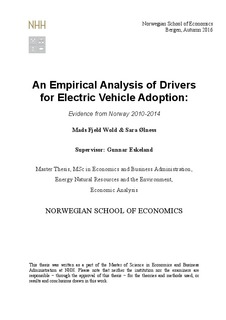An empirical analysis of drivers for electric vehicle adoption : evidence from Norway 2010-2014
Master thesis
Permanent lenke
http://hdl.handle.net/11250/2432988Utgivelsesdato
2016Metadata
Vis full innførselSamlinger
- Master Thesis [4372]
Sammendrag
We examine how government intervention in the automobile market aected
the batteryelectric
vehicle adoption in the Norwegian counties in the period between 2010 and 2014,
and what regional dierences
influenced the adoption rate. Norway has the world’s
strongest means of support for electric vehicles and represents a mature market with a
significant share of the total car fleet being electric. The government has promoted this
growth on the basis that electric vehicles are part of the solution to the climate problem.
It postulates that positive externalities from electric vehicle use are not captured by
the market, resulting in a market failure, which necessitates government intervention.
This paper explores the eects
of interventions, such as support for charging-network
development and financial incentives, on the development of electric vehicle adoption in
the 19 Norwegian counties. We use a panel data approach where econometric methods
of fixed eects,
random eects
and pooled OLS are applied. The period between 2010
and 2014 is covered on a yearly basis in the analysis. The paper contributes to existing
literature by studying regions over time. Through pooled OLS, we found charging infrastructure
to have the strongest predictive power followed by the economic gain from
free passes through toll stations. Reduced rates for EVs on ferries were expected to have
a positive eect
on EV adoption, but came out with spurious results in this analysis.
Time saved by having access to bus lanes did not turn out to have significant influence.
Some county-specific features such as coastline and elevation seem to also play a role
in the adoption of battery electric vehicles. Our results are interesting as they only
partly support existing literature, and supplement it by adding geographic and climatic
factors. The paper gives an indication for policy makers of what incentives are ecient
in driving forward EV adoption.
